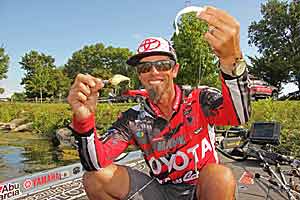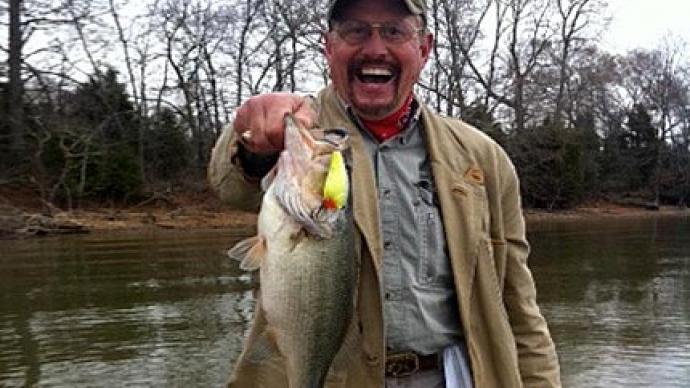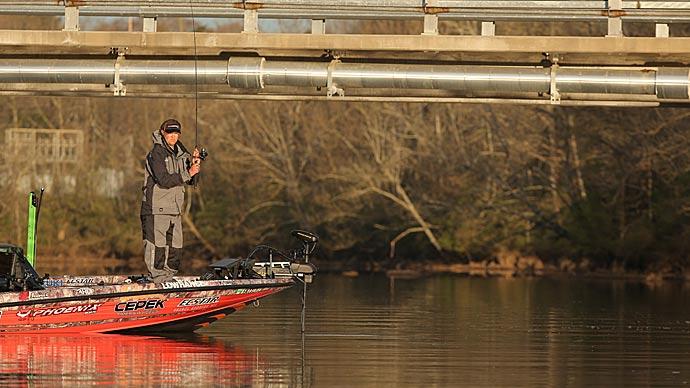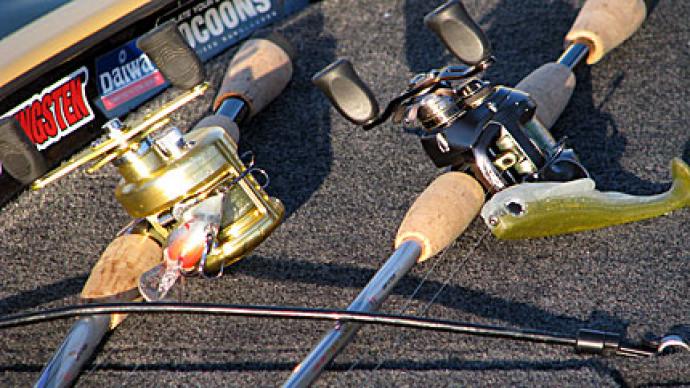
As a power fisherman, I love to fish crankbaits. The reasons are simple. I can cover an immense amount of water and elicit the reaction type of strike for inactive bass.
Know Your Crankbaits
Each crankbait has its strengths and weaknesses: wide wobble baits, tight wobble, wood baits, plastic baits, floater, and suspenders. Get comfortable with a crankbait or a family of crankbaits. Learn what depth a particular bait will run on mean line size. You can then use the available line conversion to add or take away depth. For example: Under identical casting distances, a Norman Deep Little N on 12lb. line will run approximately 10.5 feet. On 10, it will run 12 feet; on 8 it will run 13.5 feet; on 6 in the 15-foot range. On 14, it will run in the 9-foot range, on 17, it will run about 7.5 feet, and so on. On average, expect about a foot-and-a-half depth change with every line size change.
General Rules:
Generally, use wide wobble crankbaits in warmer water (60 degrees and up) to fish around wood cover. Use tight wobble crankbaits in colder water (45 to 60-degree water temp) and fish around weeds. Use cranks all year round.
Wide Wobble Baits (60 degrees and up):
Wooden - Bagleys diving B series, Poe's hundred series
Plastic - Mann's Plus Series, Fat-Free Shads
Tight Wobble Baits (45 to 60 degrees):
Wooden - Rapala Shad Rap and Risto Rap, Cedar Shads
Plastic - Bomber A family, Rattle Traps, Norman N family
Colors
Like any other lure type, I have two main concerns when choosing a color. I'm thinking about primary forage, then I'm thinking about water clarity. On the forage end, I can lump together three basic color schemes.
- Shad Imitating Baits - this includes all types of shad, herring, minnows, or shiners. Crankbait colors like pearl, white, silver, and chrome. (gel-flake colors)
- Perch /Sunfish Imitating baits include Sunfish, Bluegill, Perch, and Red Ear. Crankbait colors like chartreuse blue back, chartreuse black back, brown and chartreuse, firetiger (PERCH),
- Crawfish Imitators - Crankbait colors that involve browns, oranges, khaki, blacks, and blue in the mix.
The Deflection Factor
This is probably the most critical aspect of crankbait fishing. Ninety percent of the strikes I receive from crankbait fishing occur when the bait bounces off something or changes direction.
Think about that statement. This is the key to crankbait fishing. You have to be hitting off of cover, ripping the bait from weeds, or causing the bait to change direction to get the bites. Simple as that. Knowing this, you must first be prepared to lose some baits. Early on in my crankbait fishing, the fear of losing a 3 dollar plug was my biggest downfall.
Another key is casting at cover from many different angles. Use multiple angles when deflecting off the cover. Eventually, the crankbait will bounce off the cover in the right way to elicit a strike.
The ability for a crankbait to crash and bounce off of cover and trigger that inactive, reaction-type strike is uncanny. Even when the bait is running in open water or hitting clean bottom areas, I use techniques to cause that bait to change movement. Changing speeds is my most effective method. Also, throwing a jerk or pause into the retrieve will have the same effect.
The Bow and Arrow Release - One of the biggest tips that helped improve my deflection success has been the retrieval of snagged lures. After a friend of mine drew Rick Clunn, he showed me a modification of a retrieval technique I already knew. This lets me get out more snags which equated to more strikes as the bait freed itself and more time fishing. More of a popping rhythm to the bow and arrow technique.
Paralleling Grass
This is an excellent technique. It involves fishing grass lines(inside or outside grass lines). It helps you locate the sweet spots along long stretches of grass. The biggest bass and the most significant concentrations of bass use irregular spots in a grass line. Some form of point or turn typifies this and is often a clump separated from the main body of grass.
Again think about cranking factors when fishing grass. A tighter wobble bait with a pointier tip is better. Use line size barely to tick the grass. To find the perfect combination, I'll often rig up identical crankbaits on three different rods with different line sizes.
Also, the key to this pattern is ripping the bait free when it gets hung in the grass. My standard procedure is to first bow to the bait when hung in the grass. It will often back away and float free. If that doesn't work, I will snap the rod tip to try and free the grass.
Lipless Crankbaits
In a category by itself. A natural reaction bait. You're looking for the same deflecting principles, although it's less of a deflective bait. It's perfect for the ripping technique in grass situations and is an excellent yo-yo bait for cold water.
-
Grass - The rattle-type baits work in the same grass paralleling technique earlier. But they shine as coverage bait for unidentifiable grass lines or grass flats. You can cover a tremendous amount of water. Using the ripping technique, you can free the bait anytime it hangs in the grass.
Keep the same cranking traits in mind. A heavier line will allow you to keep the bait further up out of the grass. Choose colors according to the two golden rules: primary forage and water color. Use wider wobbling baits in warm and tighter in the cold. You can usually determine the wobble of a rattle-type bait by looking at the width of the nose of the bait. I always like to put a bigger belly hook on the bait. The nose-down retrieve protects the belly hook better.
-
Cold Water Tool - an underutilized technique. It's a fantastic fish catcher under winter and early spring conditions, say water temperature between 40-50 degrees. Again it produces that reaction type of strike associated with sluggish cold-water fish.
The yo-yo technique also imitates the action of a naturally dying shad or minnow. Yo-yoing is a lot like fishing a jig or slow roll spinnerbait. I'll cast the bait out and let it fall to the bottom on a semi-slack line. Once in a while, a bass will inhale it on the initial fall. After the bait hits bottom, I will pump or rip the bait back off the bottom. Again I will let it fall on a semi-slack line waiting for it to hit bottom. I experiment with pumping and ripping motions and speeds until the correct retrieve is found.
The Delay Factor
There are three parts to this hook-setting principle. First, I use a sweep-step type of hook set. By keeping your rod tip low and sweep-stepping up or to the side, I am increasing my chances for a good hook set. I am also slightly delaying the set, waiting to feel the fish.
Second, I am using a glass rod. The glass rod is less sensitive and more forgiving than an all-graphite rod. Again this lets the bass get the plug before I pull to set the hook.
Third, I use a monofilament line. Mono, by nature, has a stretchy characteristic to it. This enables even a little more delay in response time. (deep water is an exception)
Line Size is Key
The heavier the line, the shallower the crankbait will run. The lighter the line, the deeper the crankbait will run. Knowing this, you can use line size to determine and fine-tune the running depth of your baits. A lighter line like an 8-10 pound test can help a bait achieve maximum depth. While using heavy lines can keep your crankbait riding over heavy grass. (1 1/2 foot difference for each line size change)
Hook Size and Style
I generally like to bump up on hook size when I can. I also generally like to use a bigger belly hook. I use regular round bend hooks. I'm not too fond of the super wide-gap trebles.
Suspend Strips
I use these when I want to get a suspending type of lure. I use them in conjunction with bigger hook replacements. I probably do this more in the early spring and the heat of the summer than any other time.
Paint Markers
I use these hobby pens to give a personal modification. I often use a black marker to put on shad dots or a red marker to add some gills. I also use my paint markers to help identify my special crankbaits. Remember, every crankbait is different, so mark those exceptional performers.
Tackle and Equipment
I believe in the limber theory as far as rods go. This, for me, goes with any treble hook type of bait. The slower action of the rod not only slows down your response time a little bit but helps you land far more fish.
My rods of choice are both 6'6" and 7' models. The 7' for long cast situations and the 6'6" for up-close target casting. These rods incorporate glass into the blank, giving it that slow whippy feeling.
As for reels, I'm looking for something with three characteristics. First, I want a reel with a large capacity spool for a long cast. Second, I'm looking for a reel with a medium, not a slow retrieve. I like to have the option to reel super slow or fast. Third, I want a superior anti-reverse system. I choose the reel with a 5.1:1 ratio for long cast situations and close target casting.
Line - I use a green line for all my cranking. I use original Stren for 90 percent of my crankbait applications. Remember, I purposely want to increase my delay time. Mono helps me do that. In deeper water situations, I will use less stretchy fluorocarbon. I use line sizes ranging from 8- to 20-pound tests. I probably use 12-pound the most.
Crankbait retrievers - are a tool to have! I use both the hound dog type and the pole retrievers.




